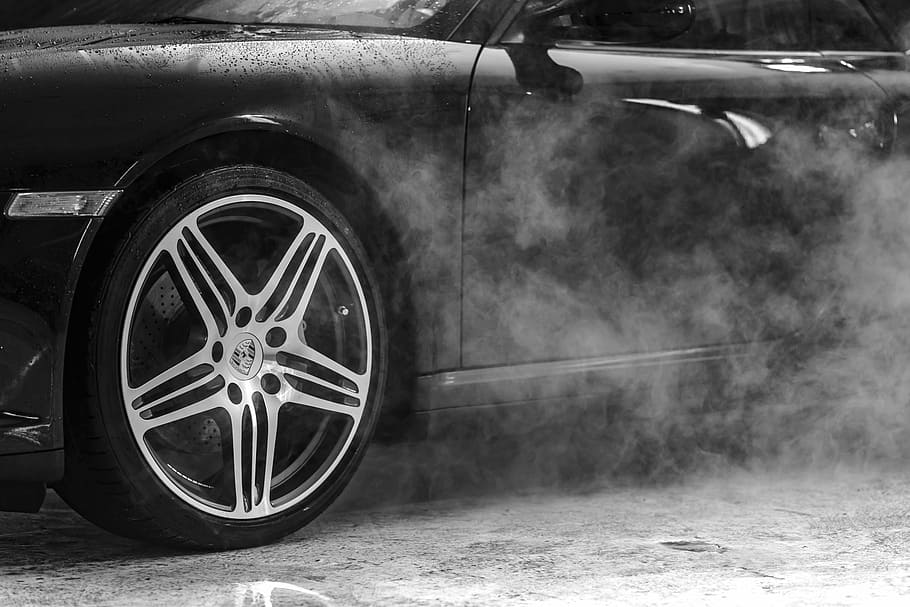Why do car enthusiasts and professionals alike swear by car waxing?
Waxing provides a protective barrier against harmful factors like UV rays, acid rain, bird droppings, and road salts that can damage your vehicle’s paint job.
Regular waxing amplifies your car’s shine, offering a lustrous finish that boosts its aesthetic appeal.
One of the joys of car waxing is watching rain or water droplets bead up and roll off, preventing potential water spots.

Different Types of Car Waxes
Navigating the world of car waxes can be overwhelming given the myriad of options available.
Natural Waxes
Carnauba, derived from palm leaves, is the most popular natural wax. It offers a rich, deep shine but may not last as long as synthetic varieties.
Synthetic Waxes
These are made from man-made polymers and tend to be longer-lasting, providing a protective layer for extended periods.
Pre-Waxing Preparations
Before diving into car waxing, ensuring your vehicle is adequately prepped is paramount for achieving the best results.
Thoroughly Wash Your Car
Begin with a thorough wash, using a pH-balanced car shampoo. Avoid dish detergents as they can strip any existing protective layers.
Clay Bar Treatment
Using a clay bar can help remove minute contaminants and debris from the car’s surface that washing alone might miss. This creates a smoother surface for the wax application.
Dry Completely
Water droplets can interfere with the waxing process, so ensure the vehicle is entirely dry. Microfiber towels are excellent as they’re lint-free and absorbent.
Step-by-Step Car Waxing Application
Achieving a lasting shine with car waxing is all about the details. Use blue car waxes for blue cars if possible.
Choose the Right Wax
Based on your car’s needs and your preferences (natural shine vs. longevity), choose between natural or synthetic waxes.
Applying the Wax
Work in Small Sections: Instead of slathering wax over large areas, work on smaller sections. This ensures even application and makes buffing manageable.
Use the Right Amount: A little often goes a long way. Start with a small amount of wax, adding more if needed.
Circular Motions: Apply the wax in circular, overlapping motions for even coverage.
Let it Dry
Once applied, let the wax dry. This can range from a few minutes to over an hour, depending on the product. Typically, when the wax turns hazy, it’s ready to be buffed off.
Buffing
Using a clean microfiber towel, buff away the dried wax using circular motions. This will reveal a shiny, protective layer beneath.
Post-Waxing Care & Maintenance
After investing your time and effort in car waxing, it’s vital to uphold that beautiful sheen. Here’s how:
Washing Post Waxing
Wait at least 48 hours before washing your car post-waxing. This gives the wax adequate time to bond with the car’s paint.
Gentle Cleaning Products
When washing, opt for pH-balanced car-specific shampoos. They clean effectively without stripping the wax layer.
Protect from Extreme Elements
Where possible, park your vehicle in shaded areas or under a carport to protect the wax from extreme sun and rain.
Common Car Waxing Mistakes to Avoid
For the best results, sidestep these frequent car waxing pitfalls.
Waxing Under Direct Sunlight
Direct sunlight can cause the wax to dry too quickly, making it difficult to buff off and possibly leaving streaks behind.
Using Dirty Applicators or Towels
Always ensure your applicators and towels are clean. Dirt or grit can scratch the paint during the waxing process.
Not Reading Product Instructions
Different waxes have varied application and drying times. Always read the instructions to ensure you’re using the product correctly.
Exploring Car Sealants
Apart from traditional waxes, car sealants have emerged as a modern alternative in vehicle protection.
What is a Car Sealant?
Car sealants are synthetic products designed to offer a protective layer on the car’s surface. They’re known for their longevity, often outlasting traditional waxes.
Wax vs. Sealant
While car waxes often provide a deeper, richer shine (especially natural waxes like carnauba), sealants offer a longer-lasting protective layer. Some enthusiasts even layer sealant beneath a car wax, combining the durability of a sealant with the rich shine of a wax.
Top Car Waxing Product Recommendations
With a multitude of products on the market, choosing the right car waxing solution can be daunting. Here’s a list of some top picks to ease the decision-making process:
Best Natural Wax
Carnauba Gold Class Wax: Praised for its natural composition, this wax offers a deep, rich shine while ensuring your vehicle is protected from external elements.
Best Synthetic Wax
Tech Shine by Aerolon: A fast and easy-to-apply solution, Tech Shine offers a long-lasting protective layer, making it a favorite among many car enthusiasts.
Best Hybrid Wax
HydroSlick Ceramic Coating HyperWax: Merging the benefits of traditional wax and ceramic coating, this product offers prolonged protection with an impeccable finish.
The Environmental Aspect of Car Care Products
In today’s eco-conscious era, the impact of car waxing products on the environment is a concern many share.
Biodegradable Formulas
Many brands now prioritize eco-friendly formulations that break down more rapidly, causing less harm to the environment.
Non-Toxic Ingredients
Opt for products free from harmful chemicals. These not only ensure your vehicle’s safety but also reduce environmental pollution.
Sustainable Packaging
Look for brands that utilize recycled or sustainable packaging to reduce the carbon footprint.
The DIY vs. Professional Car Waxing Debate
While car waxing can be a gratifying DIY project, many wonder if professional services offer better results.
DIY Advantages
Cost-Effective: You save on labor costs.
Personal Touch: Allows you to understand your vehicle’s intricacies.
Professional Advantages
Expertise: Professionals bring experience and might notice issues you overlook.
Efficiency: With specialized tools and products, they can achieve faster and potentially better results.
Frequently Asked Questions About Car Waxing
As with any subject of interest, there are always burning questions people have about car waxing. Let’s address some of the most common ones:
How often should I wax my car?
While it largely depends on the type of wax you use and your vehicle’s exposure to the elements, a general rule of thumb is to wax your car every 3 to 4 months for optimum protection and shine.
Can I wax a brand new car?
Yes, modern cars come with a paint that’s cured, so it’s safe to wax a new vehicle. However, always ensure the car’s surface is clean before waxing.
Does car waxing remove scratches?
Wax can fill in minor scratches, making them less visible, but it doesn’t “remove” them. For deeper scratches, you might need paint correction methods like polishing.
Car Waxing: More Than Just Aesthetics
While the primary motivation behind car waxing might be the dazzling finish it imparts, the benefits extend far beyond mere aesthetics:
Resale Value
A well-maintained car with a glossy finish can
fetch a higher resale value compared to a car that’s neglected.
Prolonged Paint Life
Regular waxing not only preserves the shine but also extends the life of your car’s paint job.
Reducing Maintenance Costs
With the protective layer that wax provides, your vehicle becomes less prone to damage from environmental factors, potentially saving on repair costs.
Conclusion
Car waxing is more than just a cosmetic procedure. It’s an investment in your vehicle’s longevity and appeal. Whether you’re a DIY enthusiast or prefer professional hands, understanding the essence of car waxing ensures your vehicle remains a source of pride and joy for years to come.



1 thought on “Car Waxing 101: Protecting Your Vehicle’s Shine”